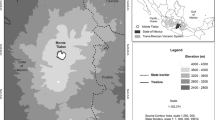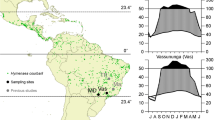Abstract
Worldwide, mangroves are a wetland biome that has both ecological and societal importance. Across the coastal region of the Bay of Bengal, the Sundarbans is the largest continual mangrove forest in the world. One way to examine growth trends in tree species is with tree-ring analysis, or dendrochronology. However, tropical applications of dendrochronology are often met with limited success because not many tropical tree species form consistently annual growth rings. Here, we aim to [1] examine if two common mangrove species in the Sundarbans, Heritiera fomes and Sonneratia apetala, produce annual growth rings and [2] better understand the environmental and climatic drivers of mangrove radial growth. We successfully developed species chronologies from S. apetala and H. fomes and found species-specific correlations with seasonal precipitation. S. apetala growth significantly correlates with climate drivers including the Madden-Julian Oscillation the El Nino-Southern Oscillation, and the Indian Ocean Dipole. Our findings show that growth rings from mangroves that experience distinct changes in seasonal climate can be used as indicators of species health and productivity.








Similar content being viewed by others
References
Ahmed R, Karmakar S (1993) Arrival and withdrawal dates of the summer monsoon in Bangladesh. International Journal of Climatology 13(7):727–740
Ashok K, Guan Z, Yamagata T (2001) Impact of the Indian Ocean dipole on the relationship between the Indian monsoon rainfall and ENSO. Geophysical Research Letters 28(23):4499–4502
Ashok K, Guan Z, Yamagata T (2003) Influence of the Indian Ocean dipole on the Australian winter rainfall. Geophysical Research Letters 30(15)
Ashok K, Guan Z, Saji NH, Yamagata T (2004) Individual and combined influences of ENSO and the Indian Ocean dipole on the Indian summer monsoon. Journal of Climate 17(16):3141–3155
Biondi F, Waikul K (2004) DENDROCLIM2002: a C++ program for statistical calibration of climate signals in tree-ring chronologies. Computational Geosciences 30(3):303–311. https://doi.org/10.1016/j.cageo.2003.11.004
Blasco F, Aizpuru M, Gers C (2001) Depletion of the mangroves of continental Asia. Wetlands Ecology and Management 9(3):255–266. https://doi.org/10.1023/A:1011169025815
Brienen RJ, Zuidema PA (2005) Relating tree growth to rainfall in Bolivian rain forests: a test for six species using tree ring analysis. Oecologia 146(1):1–12. https://doi.org/10.1007/s00442-005-0160-y
Chowdhury MQ, Schmitz N, Verheydens A, Sass-Klaassen U, Koedam N, Beeckman H (2008) Nature and periodicity of growth rings in two Bangladeshi mangrove species. IAWA Journal 29(3):265–276. https://doi.org/10.1163/22941932-90000185
Chowdhury MQ, Kitin P, De Ridder M, Delvaux C, Beeckman H (2016) Cambial dormancy induced growth rings in Heritiera fomes Buch.-ham.: a proxy for exploring the dynamics of Sundarbans, Bangladesh. Trees 30(1):227–239
Cook ER (1985) A time series analysis approach to tree ring standardization (dendrochronology, forestry, dendroclimatology, autoregressive process). University of Arizona, Disseratation
Dasgupta, S., Kamal, F. A., Khan, Z. H., Choudhury, S., & Nishat, A. (2014). River salinity and climate change: evidence from coastal Bangladesh. World Bank Policy Research Working Paper No. 6817
Dee DP, Uppala SM, Simmons AJ, Berrisford P, Poli P, Kobayashi S, Andrae U, Balmaseda MA, Balsamo G, Bauer P, Bechtold P, Beljaars ACM, van de Berg L, Bidlot J, Bormann N, Delsol C, Dragani R, Fuentes M, Geer AJ, Haimberger L, Healy SB, Hersbach H, Hólm EV, Isaksen L, Kållberg P, Köhler M, Matricardi M, McNally AP, Monge-Sanz BM, Morcrette J-J, Park B-K, Peubey C, de Rosnay P, Tavolato C, Thépaut J-N, Vitart F (2011) The ERA-interim reanalysis: configuration and performance of the data assimilation system. QJR Meteorol Soc 137:553–597. https://doi.org/10.1002/qj.828
Feller IC, Lovelock CE, Berger U, McKee KL, Joye SB, Ball MC (2010) Biocomplexity in mangrove ecosystems. Annual Review of Marine Science 2:395–417
Fritts HC (1976) Tree rings and climate. Academic Press, London, p 576
Harley GL, Grissino-Mayer HD, Horn SP (2011) The dendrochronology of Pinus elliottii in the lower Florida keys: chronology development and climate response. Tree-Ring Research 67(1):39–50
Harley GL, Grissino-Mayer HD, Franklin JA, Anderson C, Köse N (2012) Cambial activity of Pinus elliottii var. densa reveals influence of seasonal insolation on growth dynamics in the Florida keys. Trees 26(5):1449–1459
Hendon HH, Salby ML (1994) The life cycle of the madden–Julian oscillation. Journal of the Atmospheric Sciences 51(15):2225–2237
Holmes RL (1983) Computer-assisted quality control in tree-ring dating and measurement. Tree-Ring Bulletin 43(1):69–78
Huang B, Banzon VF, Freeman E, Lawrimore J, Liu W, Peterson TC, Smith TM, Thorne PW, Woodruff SD, Zhang H-M (2014) Extended Reconstructed Sea surface temperature version 4 (ERSST.v4): part I. upgrades and intercomparisons. Journal of Climate 28:911–930. https://doi.org/10.1175/JCLI-D-14-00006.1
Iftekhar MS, Saenger P (2008) Vegetation dynamics in the Bangladesh Sundarbans mangroves: a review of forest inventories. Wetl Ecol Manag 16(4):291–312. https://doi.org/10.1007/s11273-007-9063-5
Islam M, Wahab M (2005) A review on the present status and management of mangrove wetland habitat resources in Bangladesh with emphasis on mangrove fisheries and aquaculture. Aquatic Biodiversity II:165–190. https://doi.org/10.1007/1-4020-4111-X_19
Madden RA, Julian PR (1971) Detection of a 40–50 day oscillation in the zonal wind in the tropical Pacific. Journal of the Atmospheric Sciences 28(5):702–708
Madden RA, Julian PR (1972) Description of global-scale circulation cells in the tropics with a 40–50 day period. Journal of the Atmospheric Sciences 29(6):1109–1123
Madden RA, Julian PR (1994) Observations of the 40–50-day tropical oscillation—a review. Mon Weather Rev 122(5):814–837
Pethick J, Orford JD (2013) Rapid rise in effective sea-level in Southwest Bangladesh: its causes and contemporary rates. Global and Planetary Change 111:237–245. https://doi.org/10.1016/j.gloplacha.2013.09.019
Polidoro BA, Carpenter KE, Collins L, Duke NC, Ellison AM, Ellison JC et al (2010) The loss of species: mangrove extinction risk and geographic areas of global concern. PLoS One 5(4):e10095. https://doi.org/10.1371/journal.pone.0010095
Pucha-Cofrep, D. (2016). Environmental signals in radial growth, stable isotope variations and nutrient concentration of trees from different forest ecosystems in southern Ecuador (Doctoral dissertation, Erlangen, Friedrich-Alexander-Universität Erlangen-Nürnberg (FAU), Diss., 2016)
Rahman MA (2003) Top dying of Sundri (Heritiera fomes) trees in the Sundarbans: extent of damage. In: Proceedings of the National Seminar on the Sundarbans, the largest mangrove Forest on the earth: a world heritage site. University, Khulna, 180 pp
Rahman MM, Khan MNI, Hoque AF, Ahmed I (2015) Carbon stock in the Sundarbans mangrove forest: spatial variations in vegetation types and salinity zones. Wetlands Ecology and Management 23(2):269–283. https://doi.org/10.1007/s11273-014-9379-x
Ren H, Jian S, Lu H, Zhang Q, Shen W, Han W et al (2008) Restoration of mangrove plantations and colonisation by native species in Leizhou bay, South China. Ecological Research 23(2):401–407
Robert EM, Schmitz N, Okello JA, Boeren I, Beeckman H, Koedam N (2011) Mangrove growth rings: fact or fiction? Trees 25(1):49–58
Roig FA, Osornio JJJ, Diaz JV, Luckman B, Tiessen H, Medina A, Noellemeyer EJ (2005) Anatomy of growth rings at the Yucatán peninsula. Dendrochronologia 22(3):187–193
Saji NH, Yamagata T (2003) Possible impacts of Indian Ocean dipole mode events on global climate. Climate Research 25(2):151–169
Saji NH, Goswami BN, Vinayachandran PN, Yamagata T (1999) A dipole mode in the tropical Indian Ocean. Nature 401(6751):360–363
Sarker SK, Reeve R, Thompson J, Paul NK, Matthiopoulos J (2016) Are we failing to protect threatened mangroves in the Sundarbans world heritage ecosystem? Scientific Reports 6
Sass U, Killmann W, Eckstein D (1995) Wood formation in two species of Dipterocarpaceae in peninsular Malaysia. IAWA Journal 16(4):371–384
Schmitz N, Verheyden A, Kairo JG, Beeckman H, Koedam N (2007) Successive cambia development in Avicennia marina (Forssk.) Vierh. Is not climatically driven in the seasonal climate at Gazi Bay, Kenya. Dendrochronologia 25(2):87–96
SchÖNgart J, Orthmann B, Hennenberg KJ, Porembski S, Worbes M (2006) Climate–growth relationships of tropical tree species in West Africa and their potential for climate reconstruction. Global Change Biology 12(7):1139–1150
Sleen P, Groenendijk P, Vlam M, Anten NP, Bongers F, Zuidema PA (2017) Trends in tropical tree growth: re-analyses confirm earlier findings. Global Change Biology 23(5):1761–1762
Slingo JM, Rowell DP, Sperber KR, Nortley F (1999) On the predictability of the interannual behaviour of the madden-Julian oscillation and its relationship with El Niño. Quarterly Journal of the Royal Meteorological Society 125(554):583–609
Speer JH (2010) Fundamentals of tree-ring research. University of Arizona Press
Stokes M. A., and T.L. Smiley.1968.Introduction to tree-ring dating. University of Chicago, Chicago Press, IL 73 p
Trouet V, Van Oldenborgh GJ (2013) KNMI climate explorer: a web-based research tool for high-resolution paleoclimatology. Tree-Ring Research 69(1):3–13
Verheyden A, De Ridder F, Schmitz N, Beeckman H, Koedam N (2005) High-resolution time series of vessel density in Kenyan mangrove trees reveal a link with climate. The New Phytologist 167(2):425–435
Voorhees N (2000) Voortech consulting, project J2X software. Holderness, NH, USA
Wigley TM, Briffa KR, Jones PD (1984) On the average value of correlated time series, with applications in dendroclimatology and hydrometeorology. Journal of Climate and Applied Meteorology 23(2):201–213
Wilson EA, Gordon AL, Kim D (2013) Observations of the madden Julian oscillation during Indian Ocean dipole events. Journal of Geophysical Research-Atmospheres 118(6):2588–2599
Worbes M (2002) One hundred years of tree-ring research in the tropics–a brief history and an outlook to future challenges. Dendrochronologia 20(1):217–231
Zhang C (2005) Madden-julian oscillation. Reviews of Geophysics 43(2)
Acknowledgments
Field data collection for this research was supported by NASA grant # NNX11AF50G to A.F.R. The authors are thankful to the Bangladesh Forest Department for providing access to the Sundarbans for data collection.
Author information
Authors and Affiliations
Corresponding author
Electronic supplementary material
ESM 1
(DOCX 15 kb)
Rights and permissions
About this article
Cite this article
Maxwell, J.T., Harley, G.L. & Rahman, A.F. Annual Growth Rings in Two Mangrove Species from the Sundarbans, Bangladesh Demonstrate Linkages to Sea-Level Rise and Broad-Scale Ocean-Atmosphere Variability. Wetlands 38, 1159–1170 (2018). https://doi.org/10.1007/s13157-018-1079-5
Received:
Accepted:
Published:
Issue Date:
DOI: https://doi.org/10.1007/s13157-018-1079-5




